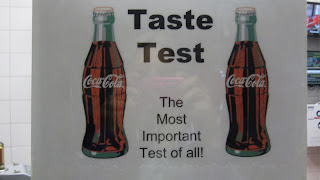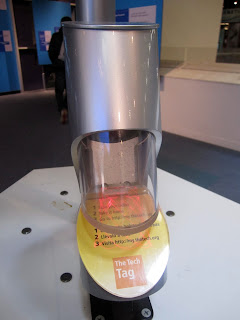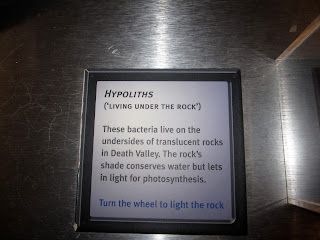The Tech Museum - Tuesday 15th March
The Tech Museum has many amazing exhibits, which have been provided to the centre through partnerships with science and technology providers. One example of this is the partnership with Microsoft, which has enabled the Tech to provide an exhibit where students teach visiting students through short film clips. On these clips students of varying ages introduce and describe a specific concept through modelling and example. Close to 25 different scientific concepts are introduced and described through this process. Each concept has its own toy to encourage students to interact and LCD screen with between 2 and 4 students presenting their explanations. The explanations are approximately a minute in length.
Explore your World has been provided through a Google partnership. Students and visitors are able to view any part of the Earth (including their home), the Moon and Mars at this exhibit on a series of 8 screens. The exhibit creates a very 3D sensation!
NASA has provided a jet-pack chair and an exhibit which allows students to view the Earth from space. Students are able to access views of hurricanes, ocean currents, the Earth by night and various others. Each view includes commentary to assist students in understanding the concept involved.
The Tech has a vast number of student-oriented activities. There are 5 science laboratories at the centre, 2 wet and 3 dry, where school groups are able to be involved in authentic rich science inquiry. These labs are targeted at grades 5 through to 12. The dry lab on rollercoasters is one of the most popular interactive lab lessons.
The Tech also runs an engineering competition for students from grades 5 to 12. This year the competition is modelled on the plastic pollution that has been found in San Francisco Bay. Students are to design and build an object to remove plastic bottles from the model version of a bay, complete with fictional endangered fish. There are two areas set up in the Tech for students to test their designs and make improvements prior to the competition day. Approximately 1200 students are involved in the competition.
On the floor of the Tech amongst the interactive exhibits there are university students and post-graduates with tables of scientific equipment who complete science experiments with students as they pass through the centre. School students and visitors benefit by being able to be involved in authentic scientific inquiry and university students are provided with the opportunity to teach and present science to the wider community.

The genetics wet lab, positioned on the general floor of the Tech was one of the best exhibits I have ever seen. Students are able to complete their own genetic work placing jellyfish DNA into bacterium. Each workstation is equipped with a touch screen computer monitor and fully labelled equipment ready to use. The computer monitor walks students through the experiment method, providing written instruction as well as filmed examples of each individual step. Students/visitors can choose to watch each step as many times as they like and a Tech education officer is always present to assist. The instructions are concise and precise. Students are able to access photographs of their incubated agar plates online.



The tickets handed to visitors/students as they enter the Tech have details of a website and every ticket has its own webpage. Students can only access their own webpages, but are able to add to their webpages by simply passing the barcode of their ticket under a scanner at the exhibits where a scanner is present. In this way they build their own science-based webpage.
The exhibits are relevant and contemporary and the inclusion of an exhibit on astrobiology was particularly impressive. The exhibit gave students evidence for the possibility of life on Mars and asked them to provide their own opinion.
One exhibit in the space science area that relates well to materials collected at NSTA was a magnetometer exhibit where students had to use a magnetometer to locate areas of magnetic activity on the Moon, just as astronauts will. This could be easily recreated for the classroom using the simple magnetometer model and a lumpy, coloured dome with magnets under it.
Wednesday 16th March
The Lawrence Hall of Science
The Lawrence Hall of Science consists of an immense number of fully resourced science laboratories, 9 in total! These laboratories are used to run laboratory workshops with visiting school students. Visiting class groups range from kindergarten right through to year 12. The Lawrence Hall of Science services an area with a radius of approximately 100 miles. Staff travel to schools in outlying areas to share science and do workshops with students. There was not as much on the main floor area of the Lawrence Hall of Science, but the vast number of laboratories on the lower level more than made up for this. There is also a program run whereby teachers are trained and these teachers then train other teachers within their region.





After school science programs also run, the focus being on providing science to elementary school students who may not be doing a lot of content and process rich science at school. University students from the University of California Berkeley volunteer and run activities during these afternoon sessions. Summer camp programs are also run at the Lawrence Hall of Science with students able to apply for scholarships to cover the cost of the camps.
The Lawrence Hall of Science had an amazing Deep Sea display and a very interactive geology display outside.
Publications linking literacy to science are currently being developed through the Lawrence Hall of Science. I shared information on Primary Connections, produced by the ASTA and Erica recorded information about this publication. Erica shared an older publication developed by the centre for elementary (primary) teachers which focuses on ensuring elementary school children are engaging in inquiry and critical thinking.
Entry to the museum is free to school aged students.
Thursday 17th March
California Academy of Sciences
The California Academy of Sciences has a number of science kits available for teachers to hire. The kits are large and very comprehensive. Teachers are required to complete professional development programs at the Academy to ensure they use the kits correctly and are able to get the most out of the equipment they hire. This is an immensely good idea, once teachers have received training on the use of the various science kits they are able to hire them year after year, or until they are able to gain resources similar to those contained in the kits.
The CAS also offers teachers professional development on how to make the most of an excursion to the CAS. Rather than have teachers equipping students with workshops which may not be suitable or relevant, they are walked through the exhibits and their content and provided with rich tasks for students to complete during their time at the CAS. Students take activity cards home with them to complete with family members, the back of the activity card contains a voucher for family entry to the CAS. It has a 15% success rate and 60% of families who attend the CAS on one of the family vouchers have not visited the centre on a previous occasion.
There are online lesson plans offered by the CAS which are extremely comprehensive, providing precise materials lists, preparation and lesson time, links to the curriculum and background information to assist teachers. http://www.calacademy.org/teachers/
The California Academy of Sciences also completes laboratory workshops with students, focused on the specialty areas based at the California Academy of Sciences and linked to California state curriculum and local teaching programs. The displays at the centre are interactive, stimulating and rich in content.
Exploratorium
The Exploratorium is not like any of the other science centres visited so far. The focus of the Exploratorium is problem solving and scientific questioning. The floor of the centre is littered with engineering type games and challenges. These pieces of machinery are non-threatening and are each accompanied by simple instruction, which include a problem and/or question, which can only be answered by interacting with the equipment. The result is a HUGELY interactive science centre. Everywhere I looked students, children, adults and families were totally engaged in scientific concepts as they focused on solving the problem posed to them. The equipment is all sturdy, effective and safe. The objects are set up related to theme, but not in the same context as the exhibits in the other Californian science centres.



There is a book available through the Exploratorium bookshop and website which allows teachers to build simple versions of the engineering/science challenges present at the Exploratorium. http://store.exploratorium.edu/browse.cfm/exploratorium-books/2,129.html
Programs are offered at this science centre for both teachers and students. Excursion workshops are available to visiting class groups, a new program is now available for students who are home schooled in the California Bay area and Exploratorium also completes school visits.
Programs for teachers are in the nature of programs for beginning teachers, particularly elementary teachers who may not have had a lot of exposure to the sciences during their training. Programs are also offered to experienced teachers and often teachers who complete these professional development opportunities become mentors at the beginning teacher education programs.



























































